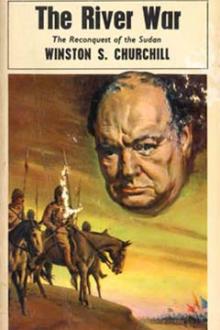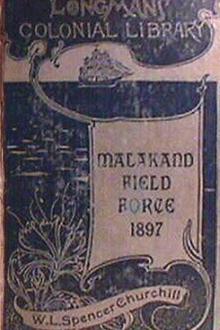The River War by Winston Churchill (spiritual books to read txt) 📕

- Author: Winston Churchill
- Performer: -
Book online «The River War by Winston Churchill (spiritual books to read txt) 📕». Author Winston Churchill
Three strong detached posts complete the defences of Suakin.
Ten miles to the northward, on the scene of Sir H. Kitchener’s unfortunate enterprise, is the fort of Handub. Tambuk is twenty-five miles inland and among the hills. Situate upon a high rock, and consisting only of a store, a formidable blockhouse, and a lookout tower, this place is safe from any enemy unprovided with artillery. Both Handub and Tambuk were at the outset of the campaign provisioned for four months.
The third post, Tokar Fort, lies fifty miles along the coast to the south.
Its function is to deprive the Arabs of a base in the fertile delta of the Tokar river. The fort is strong, defended by artillery, and requires for its garrison an entire battalion of infantry.
No description of Suakin would be complete without some allusion to the man to whom it owes its fame. Osman Digna had been for many years a most successful and enterprising Arab slave dealer. The attempted suppression of his trade by the Egyptian Government drove him naturally into opposition. He joined in the revolt of the Mahdi, and by his influence roused the whole of the Hadendoa and other powerful tribes of the Red Sea shore. The rest is upon record. Year after year, at a horrid sacrifice of men and money, the Imperial Government and the old slaver fought like wolves over the dry bone of Suakin. Baker’s Teb, El Teb, Tamai, Tofrek, Hashin, Handub, Gemaiza, Afafit—such were the fights of Osman Digna, and through all he passed unscathed. Often defeated, but never crushed, the wily Arab might justly boast to have run further and fought more than any Emir in the Dervish armies.
It had scarcely seemed possible that the advance on Dongola could influence the situation around Kassala, yet the course of events encouraged the belief that the British diversion in favour of Italy had been effective; for at the end of March—as soon, that is to say, as the news of the occupation of Akasha reached him—Osman Digna separated himself from the army threatening Kassala, and marched with 300 cavalry, 70 camelry, and 2,500 foot towards his old base in the Tokar Delta.
On the first rumour of his advance the orders of the Xth Soudanese to move via Kossier and Kena to the Nile were cancelled, and they remained in garrison at Tokar. At home the War Office, touched in a tender spot, quivered apprehensively, and began forthwith to make plans to strengthen the Suakin garrison with powerful forces.
The state of affairs in the Eastern Soudan has always been turbulent.
The authority of the Governor of the Red Sea Littoral was not at this time respected beyond the extreme range of the guns of Suakin. The Hadendoa and other tribes who lived under the walls of the town professed loyalty to the Egyptian Government, not from any conviction that their rule was preferable to that of Osman Digna, but simply for the sake of a quiet life.
As their distance from Suakin increased, the loyalty of the tribesmen became even less pronounced, and at a radius of twenty miles all the Sheikhs oscillated alternately between Osman Digna and the Egyptian Government, and tried to avoid open hostilities with either. Omar Tita, Sheikh of the district round about Erkowit, found himself situated on this fringe of intriguing neutrality. Although he was known to have dealings with Osman, it was believed that if he had the power to choose he would side with the Egyptian Government. Early in April Omar Tita reported that Osman Digna was in the neighbourhood of Erkowit with a small force, and that he, the faithful ally of the Government, had on the 3rd of the month defeated him with a loss of four camels. He also said that if the Egyptian Government would send up a force to fight Osman, he, the aforesaid ally, would keep him in play until it arrived.
After a few days of hesitation and telegraphic communication with the Sirdar, Colonel Lloyd, the Governor of Suakin, who was then in very bad health, decided that he had not enough troops to justify him in taking the risk of going up to Erkowit to fight Osman. Around Suakin, as along the Indian frontier, a battle was always procurable on the shortest notice.
When a raid has taken place, the Government may choose the scale of their reprisals. If they are poor, they will arrange a counter-raid by means of ‘friendlies,’ and nothing more will be heard of the affair. If they are rich, they will mobilise two or three brigades, and make an expedition or fight a pitched battle, so that another glory may be added to the annals of the British army. In the present instance the Egyptian Government were poor, and as the British Government did not desire to profit by the opportunity it was determined to have only a small-scale operation.
The Governor therefore arranged a plan for a demonstration at the foot of the hills near Khor Wintri by means of combined movements from Suakin and Tokar. The garrison of Suakin consisted of the 1st and half the 5th Egyptian Battalions; the 16th Egyptian reservists, who had just replaced the IXth Soudanese, and were as yet hardly formed into a military body; one squadron of cavalry, one company of Camel Corps, and some detachments of artillery. The garrison of Tokar consisted of the Xth Soudanese and a few gunners. From these troops there was organised in the second week in April, with all due ceremony, a ‘Suakin Field Force.’
The plan of campaign was simple. Colonel Lloyd was to march out from Suakin and effect a junction with the ‘Tokar Column’ at Khor Wintri, where the Erkowit road enters the hills. It was then hoped that Osman Digna would descend and fight a battle of the required dimensions in the open; after which, if victorious, the force would return to Suakin and Tokar.
In order to make the Suakin Column as mobile as possible, the whole force was mounted on camels, of which more than 1,000 were requisitioned, as well as 60 mules and 120 donkeys. Two hundred Arabs accompanied the column to hold these beasts when necessary. Six days’ forage and rations, one day’s reserve of water, 200 rounds per man, and 100 shell per gun were carried.
At five o’clock on the afternoon of Tuesday, the 14th of April, the troops paraded outside the walls of Suakin, and bivouacked in the open ready to march at daylight.
The next morning the column, which numbered about 1,200 men of all arms, started. After marching for four or five hours in the direction of Khor Wintri the cavalry, who covered the advance, came in contact with the Dervish scouts. The force thereupon assumed an oblong formation: the mixed Soudanese company and the two guns in front, three Egyptian companies on each flank, the Camel Corps company in the rear, and the transport in the centre. The pace was slow, and, since few of the camels had ever been saddled or ridden, progress was often interrupted by their behaviour and by the broken and difficult nature of the country. Nevertheless at about four o’clock in the afternoon, Teroi Wells, eight miles from Khor Wintri, were reached; and here, having marched nineteen miles, Colonel Lloyd determined to halt. While the infantry were making the zeriba, the cavalry were sent on under Captain Fenwick (an infantry officer employed on the Staff) to gain touch with the Tokar force, who were expected to have already reached the rendezvous. Apparently under the belief that Omar Tita and his Arabs would give timely notice of an attack, the cavalry seem to have neglected many of the usual precautions, and in consequence at about five o’clock, when approaching Khor Wintri, they found themselves suddenly confronted with a force of about 200 Dervish horsemen supported by a large body of infantry. The squadron wheeled about with promptitude, and began to retire at a trot. The Dervish horsemen immediately pursued. The result was that the Egyptians began a disorderly flight at a gallop through the thick and treacherous scrub and over broken, dangerous ground. Sixteen horses fell; their riders were instantly speared by the pursuers. Rallying thirty-eight troopers, Captain Fenwick seized a rocky hillock, and dismounting with the natural instinct of an infantry soldier, prepared to defend himself to the last. The remainder of the squadron continued their flight, and thirty-two troopers, under an Egyptian officer (whose horse is said to have bolted), arrived at the Teroi zeriba with the news that their comrades had been destroyed, or had perhaps ‘returned to Suakin,’
and that they themselves had been closely followed by the enemy. The news caused the gravest anxiety, which was not diminished when it was found that the bush around the zeriba was being strongly occupied by Dervish spearmen. Two mounted men, who volunteered for the perilous duty, were sent to make their way through this savage cordon, and try to find either the remainder of the cavalry or the Tokar Column. Both were hunted down and killed. The rest of the force continued in hourly expectation of an attack.
Their suspense was aggravated towards midnight, when the Dervishes began to approach the zeriba. In the darkness what was thought to be a body of horsemen was seen moving along a shallow khor opposite the right face of the defence. At the same moment a loud yell was raised by the enemy on the other side. An uncontrolled musketry fire immediately broke out. The guns fired blindly up the valley; the infantry wildly on all sides.
The fusillade continued furiously for some time, and when by the efforts of the British officers the troops were restrained, it was found that the Dervishes had retired, leaving behind them a single wounded man.
Occasional shots were fired from the scrub until the morning, but no fresh attack was attempted by the Dervishes.
Meanwhile Captain Fenwick maintained his solitary and perilous position on the hillock. He was soon surrounded by considerable bodies of the enemy, and as soon as it became dark he was sharply attacked. But the Dervishes fortunately possessed few rifles, and the officers and troopers, by firing steady volleys, succeeded in holding their ground and repulsing them.
The sound of the guns at Teroi encouraged the Egyptians and revealed the direction of their friends. With the daylight the Dervishes, who seem throughout the affair to have been poor-spirited fellows, drew off, and the detachment, remounting, made haste to rejoin the main body.
The force, again united, pursued their way to Khor Wintri, where they found the column from Tokar already arrived. Marching early on the 15th, Major Sidney with 250 men of the Xth Soudanese, the only really trustworthy troops in the force, had reached Khor Wintri the same afternoon. He drove out the small Dervish post occupying the khor, and was about to bivouac, when he was sharply attacked by a force of Arabs said to have numbered 80 horsemen and 500 foot. The Soudanese fought with their usual courage, and the Dervishes were repulsed, leaving thirty dead upon the ground.
The regulars had three men wounded.
Up to this point Colonel Lloyd’s plan had been successfully carried out.
The columns from Suakin and Tokar had effected a junction at Khor Wintri on the Erkowit road. It now remained to await the attack of Osman Digna,





Comments (0)